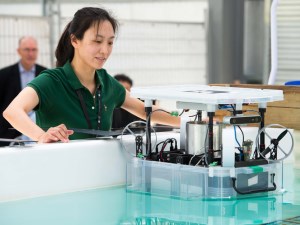A nuclear-focussed International Robotics Challenge has been held in Australia to demonstrate the important role robots can play in monitoring nuclear sites.
The robots are used to capture important data to prevent their misuse for the development of nuclear weapons.
The Robotics Challenge was co-hosted by the International Atomic Energy Agency (IAEA) and CSIRO’s Data61, Australia’s leading data innovation network.
It demonstrated how robotics can be used to reliably undertake repetitive measurements of nuclear material in parts of nuclear facilities that may be difficult or unsafe for humans to access.
The IAEA uses these important measurements to verify that countries are not misusing nuclear materials and facilities to develop nuclear weapons.
These measurements are part of a system of “safeguards” carried out by the IAEA to ensure countries adhere to international treaty commitments designed to and prevent illicit nuclear weapons programs.
Twelve teams from nine countries took part in two challenge categories.
Participating teams included Hungary, Republic of Korea, Israel, Switzerland, USA, UK, Canada, Germany and Finland.
The winning team will be named next year following analysis of challenge results and will have the chance to receive funding and commercialise their technology through the IAEA.

Australia, which co-hosted the Challenge in Pullenvale, QLD, did not compete due to technical problems.
Vital inspection tasks
As part of the challenge, one task was conducted on ground, and the other on the surface of water, simulating vital inspection tasks normally undertaken manually by IAEA Safeguards Inspectors.
Andrey Sokolov, Technology Foresight Officer at the IAEA, said robots have the potential to carry out some of these inspection tasks currently conducted by inspectors.
“The Robotics Challenge aims to test the suitability of new robotic designs to help the IAEA fulfil some of its verification tasks more efficiently, freeing up inspectors to concentrate more on examining how facilities are being used,” Mr Sokolov said.
“We’re excited to host this Challenge with the team of robotics experts at CSIRO’s Data61.”
Professor Dr Alberto Elfes, Chief Research Scientist & Group Leader for Robotics at CSIRO’s Data61, said that in addition to nuclear safeguards, the organisation’s world-leading Robotics Research Group was already making an impact in industries such as aerospace, manufacturing, mining, oil and gas, biosecurity and others.
Game-changing applications
“Robots have a multitude of game-changing applications across industry, and there are major safety, productivity and efficiency gains to be made from adopting them,” he said.

“Zebedee, our high-accuracy 3D laser mapping technology, was commercialised and is already being used around the world by 25 multinational organisations.
“It was recently trialled by the IAEA in nuclear safeguards inspections. Legged robots, in particular, are a key technology to traverse and sense dangerous or confined spaces in place of humans”
Decades of experience
The Australian Safeguards and Non-Proliferation Office (ASNO) of the Department of Foreign Affairs and Trade is the regulatory authority responsible for nuclear safeguards and nuclear security in Australia. ASNO collaborates with the IAEA on the development of technology for nuclear safeguards.
Dr Robert Floyd, Director General ASNO, said: “The IAEA has decades of experience in verifying that nuclear facilities are being used solely for peaceful purposes, but its technology toolkit needs to adapt so it can keep apace with the challenge of inspecting more and more nuclear material within a reducing budget. IAEA Technology Challenges such as this have great potential to find solutions to better equip inspectors in their important task.”
Industries around the world are evolving at the intersection of digital technologies and physical environments.
CSIRO’s Data61 is working closely with a network of government, corporates and academia – including the IAEA and ASNO – to apply world class robotics technologies to advance these industries and make them safer and more efficient.



